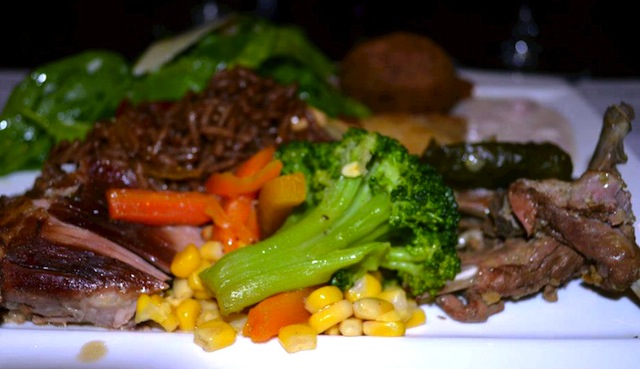
“Jordan is actually a very old wine country. They discovered vines from Petra from 2,000 years ago.”
I’m at Zumot Winery, owned by Mr. Omar Zumot, near downtown Amman sampling the organic Saint George Wine of Jordan. The space is grand yet cozy, with a spacious interior, two floors, walls adorned with local artwork, a long tasting table, cozy couches and shelves upon shelves of wine bottles that make you feel like you’re in a vino-inspired library. Zumot planted his first grapes in 1996 in the fertile region of Madaba. While Jordan — or the Middle East for that matter — isn’t typically known for their wine, Zumot makes strategic use of Jordan’s reliable climate (the dryness eliminates common plant diseases) and soil rich in clay and basalt. Not only that, but they do it sustainably.
“If you work with nature you have a healthy product,”explains Arnist, a staff member at the winery. “If you use chemicals you’ll have chemicals in your body.”
Zumot Winery doesn’t use chemicals. In fact, they create biodynamic ecosystems on their vineyards where animals cohabitate to create an excellent grape-growing scenario. For example, while owls scare away the mice, sheep are brought onto the property to defecate and naturally fertilize the soil. This leads to an impressively delicious wine that you can feel good about drinking.

Traditional Jordanian foods at Zumot Winery & Vineyards
Because I’m with a large group of about 20 people, the winery has seated us at a long glass table with wine glasses already set out. Not only that, but they’ve had it catered with traditional Jordanian foods like samosas, spiced rice with fish, stuffed grape leaves topped with lamb, sheep with vegetables, falafel and salad. After everyone tops their plate with typical fare, the tasting begins, moving from white to red. We start off with a Tokai, a grape famous in Europe that has been planted in Jordan by the winery. The liquid has a greenish straw color with an apricot nose and hint of exotic fruits that adds some contrast to the spice-rich meal. Moving on to their Chardonnay, I notice the flavor is much more buttery and olive-flavored than a usual Chardonnay, although it still has the usual tastes of citrus that pair well with the flaky white fish on my plate.
When people begin asking questions about flavors and pairings, Arnist explains, “Drinking wine is never rational. It’s always emotional. It depends where you are, the time of year, who you’re with. Everyone’s taste buds are different and influence what you feel and taste in a wine.”
I appreciate the winery’s unpretentious approach to wine tasting. It’s true that everyone tastes differently. For example, while I immediately notice the Saint George Sauvignon Blanc’s mix of mint and vanilla, the man sitting next to me has a fruitier experience. For me, each sip transports me to the French Polynesian island of Tahaa where everything smelled sweet and fresh. As I had just been there touring vanilla plantations and hiking through lush foliage, the rich wine makes me smile at the memory.

Zumot Winery
While the whites are good, I particularly enjoy Zumoy Winery’s reds, most notably their Graziano. While it’s very fruit-forward with flavors of berries and plums, there is also a hint of eucalyptus that reminds me of how much I love trying new wine flavors. Their Shiraz-Grenache — a deep ruby-red wine with intense black cherry aromas and hints of dark chocolate — also makes me smile as I remember an experience I had making my own blend of Shiraz, Grenache and Mouvedre at Penfolds in South Australia.
Around the table everyone is laughing and talking, the volume of the room growing increasingly more boisterous.
“As you drink, the evening becomes more interesting,” laughs Arnist, who is sipping an interesting glass of Merlot with flavors of bacon, cashew, plum and touch of tobacco. While I’m not usually a big Merlot fan, I particularly like how the smokey flavor blends with the spice of the lamb and heartiness of the potato-stuffed grape leaf.

Knafeh
For those visiting, large groups can organize a similar situation and have the tasting catered. Alternatively, individual tastings are possible with an appointment and allow you to sample an array of wines in a structured manner with baguettes, cheese and cold cuts.
Photo Credit: Knafeh via avlxyz

Jessica Festa is the editor of the travel sites Jessie on a Journey (http://jessieonajourney.com) and Epicure & Culture (http://epicureandculture.com). Along with blogging at We Blog The World, her byline has appeared in publications like Huffington Post, Gadling, Fodor’s, Travel + Escape, Matador, Viator, The Culture-Ist and many others. After getting her BA/MA in Communication from the State University of New York at Albany, she realized she wasn’t really to stop backpacking and made travel her full time job. Some of her most memorable experiences include studying abroad in Sydney, teaching English in Thailand, doing orphanage work in Ghana, hiking her way through South America and traveling solo through Europe. She has a passion for backpacking, adventure, hiking, wine and getting off the beaten path.








